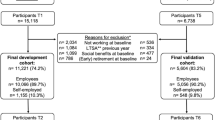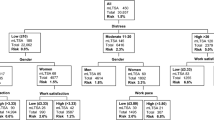Abstract
Purpose To validate Dutch prognostic models including age, self-rated health and prior sickness absence (SA) for ability to predict high SA in Danish eldercare. The added value of work environment variables to the models’ risk discrimination was also investigated. Methods 2,562 municipal eldercare workers (95 % women) participated in the Working in Eldercare Survey. Predictor variables were measured by questionnaire at baseline in 2005. Prognostic models were validated for predictions of high (≥30) SA days and high (≥3) SA episodes retrieved from employer records during 1-year follow-up. The accuracy of predictions was assessed by calibration graphs and the ability of the models to discriminate between high- and low-risk workers was investigated by ROC-analysis. The added value of work environment variables was measured with Integrated Discrimination Improvement (IDI). Results 1,930 workers had complete data for analysis. The models underestimated the risk of high SA in eldercare workers and the SA episodes model had to be re-calibrated to the Danish data. Discrimination was practically useful for the re-calibrated SA episodes model, but not the SA days model. Physical workload improved the SA days model (IDI = 0.40; 95 % CI 0.19–0.60) and psychosocial work factors, particularly the quality of leadership (IDI = 0.70; 95 % CI 053–0.86) improved the SA episodes model. Conclusions The prognostic model predicting high SA days showed poor performance even after physical workload was added. The prognostic model predicting high SA episodes could be used to identify high-risk workers, especially when psychosocial work factors are added as predictor variables.



Similar content being viewed by others
References
Vingård E, Alexanderson K, Norlund A. Consequences of being on sick leave. Scand J Public Health. 2004;63(Suppl32):207–15.
Virtanen M, Kivimäki M, Vahtera W, Elovainio M, Sund R, Virtanen P, Ferrie JE. Sickness absence as a risk factor for job termination, unemployment, and disability pension among termporary and permanent employees. Occup Environ Med. 2006;63:212–7.
Borg V, Faber A, Fallentin N. Sick leave among eldercare workers—a comparison between different occupations. Copenhagen: The National Research Centre for the Working Environment (report 11); 2007.
Krane L, Fleten N, Stapelfeldt CM, Nielsen CV, Jensen C, Johnsen R, Braaten T. Comparison of sick leave patterns between Norway and Denmark in the health and care sector: a register study. Scand J Public Health. 2013;41:684–91.
Borg V, Faber A, Fallentin N. Sick leave among eldercare workers—a comparison between different healthcare professions. Copenhagen: The National Research Centre for the Working Environment (report 12); 2007.
Taimela S, Malmivaara A, Justén S, Läärä E, Sintonen H, Tiekso J, Aro T. The effectiveness of two occupational health intervention programmes in reducing sickness absence among employees at risk. Two randomised controlled trials. Occup Environ Med. 2008;65:236–41.
Kant IJ, Jansen NW, van Amelsvoort LG, van Leusden R, Berkouwer A. Structured early consultation with the occupational physician reduces sickness absence among office workers at high risk for long-term sickness absence: a randomized controlled trial. J Occup Rehabil. 2008;18:79–86.
Roelen CA, van Rhenen W, Bültmann U, Groothoff JW, van der Klink JJ, Heymans MW. The development and validation of two prediction models to identify employees with high sickness absence. Eur J Public Health. 2013;23:128–33.
McGinn TG, Guyatt GH, Wyer PC, Naylor CD, Stiell IG, Richardson WS. Users’ guide to the medical literature XXII: how to use articles about clinical decision rules. JAMA. 2000;284:79–84.
Roelen CA, Bültmann U, van Rhenen W, van der Klink JJL, Twisk JWR, Heymans MW. External validation of two prediction models identifying employees at risk of high sickness absence: cohort study with 1-year follow-up. BMC Public Health. 2013;13:105.
Roelen CA, Heymans MW, Twisk JW, van Rhenen W, Pallesen S, Bjorvatn B, Moen BE, Magerøy N. Updating and prospective validation of a prognostic model for high sickness absence. Int Arch Occup Environ Health. doi:10.1007/s00420-014-0942-9.
Lund T, Labriola M, Christensen KB, Bültmann U, Villadsen E. Physical work environment risk factors for long term sickness absence: prospective findings among a cohort of 5357 employees in Demark. BMJ. 2006;332:449–52.
Stapelfeldt CM, Jensen C, Andersen NT, Fleten N, Nielsen CV. Validation of sick leave measures: self-reported sick leave and sickness benefit data from a Danish national register compared to multiple workplace-registered sick leave spells in a Danish municipality. BMC Public Health. 2012;12:661.
Ware JE, Kosinski MA, Turner-Bowker DM, Gandek B. User’s manual for the SF-12v2® Health Survey. Lincoln (RI): Quality Metric Incorporated; 2002.
Hollmann S, Klimmer F, Schmidt KH, Kylian H. Validation of a questionnaire for assessing physical work load. Scand J Work Environ Health. 1999;25:105–14.
Pejtersen JH, Kristensen TS, Borg V, Bjorner JB. The second version of the Copenhagen Psychosocial Questionnaire. Scand J Public Health. 2010;38(Suppl 3):8–24.
Kristensen TS, Hannerz H, Hogh A, Borg V. The Copenhagen Psychosocial Questionnaire—a tool for the assessment and improvement of the psychosocial work environment. Scand J Work Environ Health. 2005;31:438–49.
Thorsen SV, Bjørner JB. Reliability of the Copenhagen Psychosocial Questionnaire. Scand J Public Health. 2010;38(Suppl 3):25–32.
Steyerberg EW. Clinical prediction models. New York: Springer; 2009.
Kundu S, Aulchenko YS, van Duijn CM, Janssens AC. PredictABEL: an R package for the assessment of risk prediction models. Eur J Epidemiol. 2011;26:261–4.
Fad J, Upadhye S, Worster A. Understanding receiver operating characteristic (ROC) curves. CJEM. 2006;8:19–20.
Steyerberg EW, Vickers AJ, Cook NR, Gerds T, Gonen M, Obuchowski M, Pencina MJ, Kattan MW. Assessing the performance of prediction models: a framework for traditional and novel measures. Epidemiology. 2010;21:128–38.
Sundström J, Byberg L, Gedeborg R, Michaëlsson K, Berglund L. Useful tests of usefulness of new risk factors: tools for assessing reclassification and discrimination. Scand J Public Health. 2011;39:439–41.
Henderson M, Glozier N. Holland Elliot K. Long term sickness absence. BMJ. 2005;330:802–3.
Johansson G, Lundberg I. Adjustment latitude and attendance requirements as determinants of sickness absence or attendance: empirical tests of the illness flexibility model. Soc Sci Med. 2004;58:1857–68.
Kuoppala J, Lamminpää A, Liira J, Vainio H. Leadership, job well-being and health effects—a systematic review and a meta-analysis. J Occup Environ Med. 2008;50:904–15.
Schreuder JA, Roelen CA, van Zweeden NF, Jongsma D, van der Klink JJ, Groothoff JW. Leadership styles of nurse managers and registered sickness absence among their nursing staff. Health Care Manag Rev. 2011;36:58–66.
Munir F, Burr H, Hansen JV, Rugulies R, Nielsen K. Do positive psychosocial work factors protect against 2-year incidence of long-term sickness absence among employees with and those without depressive symptoms? A prospective study. J Psychosom Res. 2011;70:3–9.
Stapelfeldt CM, Nielsen CV, Andersen NT, Krane L, Fleten N, Borg V, Jensen C. Are environmental characteristics in the municipal eldercare, more closely related with frequent short sick leave spells among employees than with total sick leave: a cross-sectional study. BMC Public Health. 2013;13:578.
Justice AC, Covinsky KE, Berlin JA. Assessing the generalizability of prognostic information. Ann Intern Med. 1999;130:515–24.
Persson R, Kristiansen J. The challenge of assessing the psychosocial work environment: why some self-reports should not be interpreted as environmental exposures. Occup Environ Med. 2012;69:932–3.
Rugulies R. Studying the effect of the psychosocial work environment on risk of ill-health: towards a more comprehensive assessment of working conditions. Scand J Work Environ Health. 2013;38:187–92.
Taimela S, Justén S, Aronen P, Sintonen H, Läärä A, Malmivaara A, Tiekso J, Aro T. An occupational health intervention programme for workers at high risk for sickness absence. Cost effectiveness analysis based on a randomised controlled trial. Occup Environ Med. 2008;65:242–8.
Koopmans PC, Roelen CA, Groothoff JW. Risk of future sickness absence in frequent and long-term absentees. Occup Med. 2008;58:268–74.
Rongen A, Robroek SJW, van Lenthe FJ, Burdorf A. Workplace health promotion: a meta-analysis of effectiveness. Am J Prev Med. 2013;44:406–15.
Conflict of interest
The authors Corné Roelen, Christina Malmose Stapelfeldt, Martijn Heymans, Willem van Rhenen, Merete Labriola, Claus Vinther Nielsen, Ute Bültmann, and Chris Jensen declare that they have no conflict of interest.
Informed consent
Eldercare workers participated in the Working in Eldercare Survey in 2005. For the present study, available survey data were used without collecting new participant data. The Danish Data Protection Agency approved of using the survey data (reference 2012-41-1290). All procedures followed were in accordance with the Helsinki Declaration of 1975 as revised in 2000.
Author information
Authors and Affiliations
Corresponding author
Rights and permissions
About this article
Cite this article
Roelen, C.A.M., Stapelfeldt, C.M., Heymans, M.W. et al. Cross-National Validation of Prognostic Models Predicting Sickness Absence and the Added Value of Work Environment Variables. J Occup Rehabil 25, 279–287 (2015). https://doi.org/10.1007/s10926-014-9536-3
Published:
Issue Date:
DOI: https://doi.org/10.1007/s10926-014-9536-3




